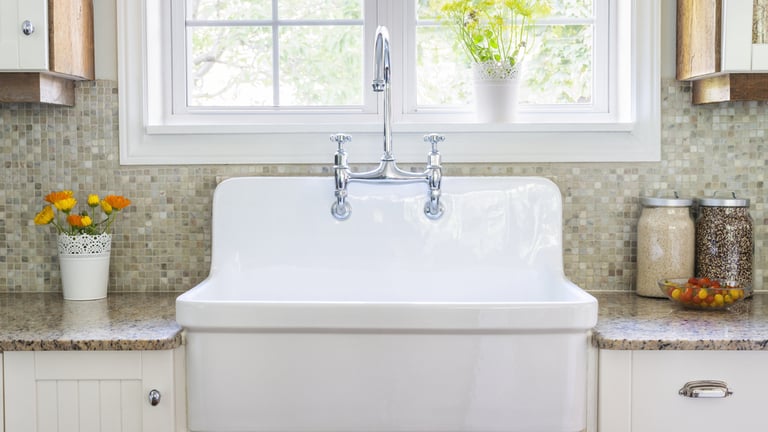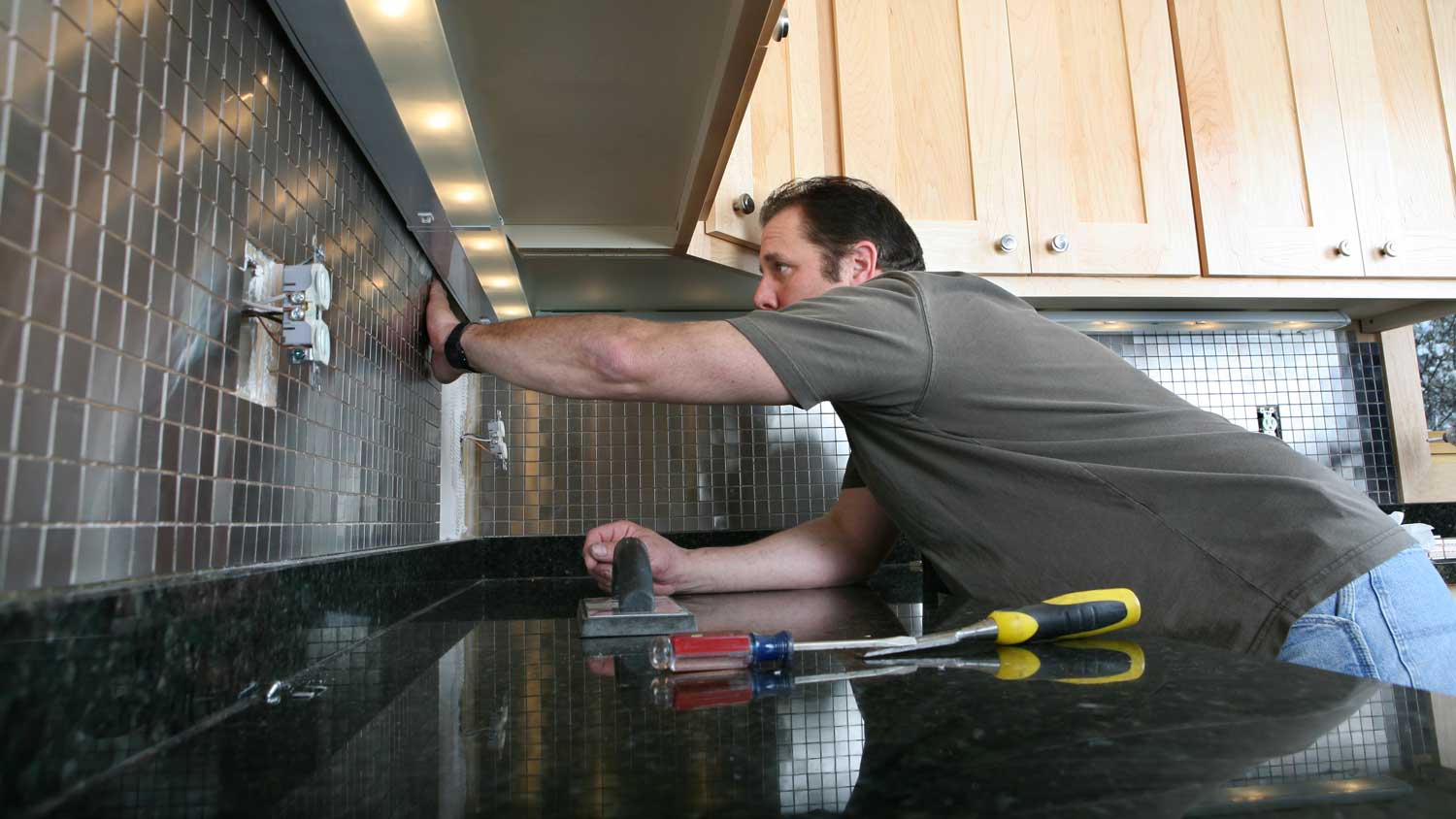.jpg?impolicy=leadImage)
Sealing your grout goes a long way toward extending its life span. This guide breaks down the cost factors for sealing grout, including size, materials, and labor.
Design isn't the only factor to consider


Due to the sheer volume of styles and designs, call a backsplash installation pro to help you narrow down your backsplash options based on your budget.
Ceramic is cost-effective and comes in the largest selection of colors, shapes, and designs, but it isn’t as strong as porcelain.
Options like natural stone and wood offer a high-end look but require extra maintenance because of their high porosity.
Glass is a powerhouse of durability and design, but it can eat into your budget, especially if you choose smaller tiles that take more labor to install.
Metal backsplashes are some of the best to DIY, but they’re vulnerable to splashes from acidic liquids like vinegar, lemon juice, or wine.
Your backsplash is an opportunity to enhance your kitchen with personal detail, adding a stunning flash of color or unique texture to the room. It’s functional, too, protecting the walls from water, grease, or splattered marinara.
Before you pick out your backsplash, consider all the pros and cons of each material to ensure you get the design that makes the most sense for your home. To help you make the best choice for your home, here’s a breakdown of the best materials for kitchen backsplash, plus their costs, pros, and cons.

Ceramic tiles are an ever-popular choice for kitchen backsplashes, and they tend to be kind on the wallet, typically $20 to $25 per square foot. You’ll want to look for Group-1 and Group-2 tiles, which have a hardness appropriate for walls.
| Pros | Cons |
|---|---|
| Cost-effective | Fragile, prone to chipping |
| Available in many colors, shapes, and designs | Porous, more likely to stain |
| Easy to clean; no special products required | Variations in production that require ordering everything at once |
Best for: Those looking for a budget-friendly and aesthetically pleasing way to protect their kitchen walls from cooking and cleaning splashes.

Porcelain tiles are another classic, affordable option. They’re strong, repel water, and don’t stain easily. But their durability means porcelain is pricier than ceramic, around $35 per square foot.
| Pros | Cons |
|---|---|
| Dense and durable | Difficult to DIY |
| Stain, scratch, and water-resistant | Pricey |
| Doesn’t show imperfections | Brittle, prone to cracking |
Best for: Anyone that has a little more to spend on a more durable (but similarly visually appealing) backsplash alternative to ceramic tiles.

The lines and general textured look of natural stone—such as travertine, quartz, granite, and marble can add an appealing, organic look to your kitchen. Still, these materials will require extra maintenance as they are very porous. The cost greatly depends on which stone you select, ranging from $30 per square foot for granite and up to $200 per square foot for the cost of a marble backsplash.
| Pros | Cons |
|---|---|
| Unique and beautiful | Needs resealing |
| Budget-friendly options | Highly porous |
| Textured | Special cleaning products required |
Best for: Home cooks trying to craft a specific ambience, and don’t mind doing a bit of extra maintenance to make it happen.

Although natural stone tiles aren’t the most expensive option for kitchens, they definitely aren’t the most budget-friendly, either—especially when you compare the difference in price between quartz and tile backsplashes.
If you don’t have the budget for real stone but your heart is still set on that particular style, consider stone veneer instead. This alternative is made to mimic the look and feel of natural stone, but for just $6 and $9 per square foot instead of $15 to $30.
| Pros | Cons |
|---|---|
| Easier to clean and less likely to stain than real stone | Not as authentic as real stone |
| Less expensive than real stone | Not as environmentally-friendly |
Best for: Those looking for a budget-friendly, easier-to-clean alternative to natural stone.

Available in several finishes, glass mosaics can offer a luxurious, artistic touch to any kitchen, but they are one of the more expensive choices on our list, coming in around $20 to $35 per square foot, with some options as high as $50 per square foot.
| Pros | Cons |
|---|---|
| Doesn’t require special cleaning products like natural stone | Cleaning can be complicated with more intricate designs |
| Wide array of design choices | More expensive than other options |
| Easy to install because they can be arranged on fiberglass mesh | Mass-produced, so not always unique |
Best for: Those looking for a more refined alternative to ceramic or porcelain tile or a project they can easily do themselves.

A good DIY, eco-friendly option, wood can be used as a backsplash if properly sealed and protected, but it does require regular maintenance. The price can vary depending on the wood used but is usually between $3 and $40 per square foot.
| Pros | Cons |
|---|---|
| Environmentally friendly | Can’t be installed within 18 inches of gas burners because of fire risk |
| Works well with all design styles | Must be sealed properly and treated regularly with mineral oil to prevent water damage |
| Wide variety of wood styles | May need to be sanded and refinished every 10 years; damages more easily than alternatives |
Best for: Those who like a nature-inspired aesthetic and don’t do a lot of messy cooking.

A comparatively low-cost (averaging $3 per square foot for tin, with costs higher for stainless steel at $35 per square foot), contemporary choice with options ranging from polished stainless steel to embossed tin tiles, a metal backsplash is easy-to-install and non-flammable but can be damaged by highly acidic items.
| Pros | Cons |
|---|---|
| Easy DIY installation | Prone to scratching and dents |
| Wide pattern and design options | Acidic items (like lemon, vinegar, and coffee) can erode finish |
| Easy to clean | Gentle cleaning required |
| Inexpensive | Smudges and fingerprints will show more easily |
Best for: Frequent home cooks needing a no-fuss backsplash option that’s easy to care for.
You should consider a variety of factors before you choose your backsplash. Here are a few things to keep in mind:
What color are your cabinets, your countertops, and your floors? You’ll want your kitchen backsplash to pair well with the tones and overall style of the rest of the room. That said, a backsplash can also add contrast or a dramatic highlight to an otherwise simple look.
You can get creative with ideas to match your backsplash to white kitchen cabinets.
Are you addicted to cooking blogs and always learning new techniques to perfect your bolognese? You may want to select a backsplash material that isn’t prone to staining, is less porous, and overall more durable. If you rarely turn on the stove, aesthetics might be paramount.
As always, some materials are more expensive than others. Tiles in standard sizes are often less expensive than ornate mosaics.
Kitchens benefit from green drywall instead of white drywall because it's more moisture- and mold-resistant. If your kitchen doesn't already have green drywall, hire a pro to install it during a remodel.
The average backsplash cost is $1,000, but you'll save on labor fees if you DIY—most pros charge an hourly rate of $40 to $60. Unlike more complicated kitchen renovations (like installing new plumbing or gas lines), it’s relatively easy to DIY a backsplash, and can be even easier depending on which material you use.
However, if you don’t want to risk any mistakes and more costs down the line, don’t hesitate to hire a backsplash installer near you. Doing so can add to the overall backsplash installation cost, but you won’t have to worry about pricey replacements or repairs due to faulty construction the way you might by doing it yourself.
C.E. Larusso contributed to this piece.
From average costs to expert advice, get all the answers you need to get your job done.
.jpg?impolicy=leadImage)
Sealing your grout goes a long way toward extending its life span. This guide breaks down the cost factors for sealing grout, including size, materials, and labor.

Tile varies dramatically in price, but there’s something for every budget. This guide will help you plan for tile installation costs, no matter the project.

The cost to install travertine tile depends on materials and the size of the project. This guide to travertine tile cost will help you budget accordingly.

Nothing cures a dated bathroom like fresh tile and grout. Learn how to retile a bathroom, including removing old tiles to grouting and caulking the new tiles.

Can you tile over tile? Yes—if you prep right. Learn how to prep, choose adhesive, and avoid common mistakes for a successful tile-over-tile project.

Choosing the best grout for kitchen backsplashes depends on your priorities and backsplash design. Learn how to choose the best grout for your backsplash.